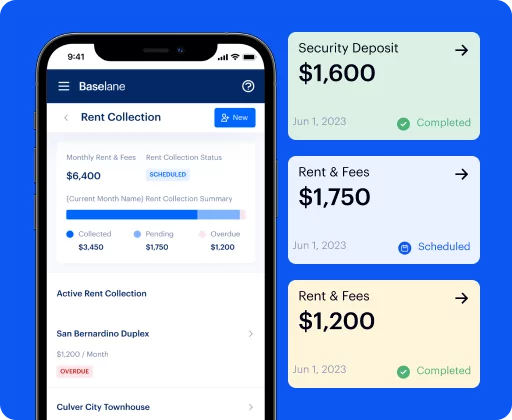When you find a new tenant for your rental property, you need to agree on some terms of the deal: when the tenant can move in, how long they can stay, and how much they’ll pay in rent each month. But how do you go about formalizing the terms and what’s included?
If you’re renting out a property for the first time and need to write a lease, you’ll find everything you need to know in this beginner landlord’s guide to lease agreements.
1. What is a Lease Agreement?
A lease agreement (frequently shortened to just “lease”) is a contract between you and your tenant that sets out the rules for their tenancy. The lease will define what you agree to provide to your tenant and what they agree to pay in return.
A lease agreement is most commonly a formal document, although a verbal lease agreement is still legally binding.
2. What Components Do I Need to Include in My Lease Agreement?
At a minimum, your lease agreement needs to spell out who is entering into the agreement, describe the property being rented, state how long the lease is for, and give details of what rent will be paid.
However, you’ll probably want to include much more detail in the lease to protect yourself against bad tenants and potential conflicts. As a starting point, include sections on:
- Parties to the agreement. This section should state the legal names and contact information of everyone who is a party to the agreement. That includes you and any other lessors, and all the people who will be living in the rental unit.
- Description of the rental unit. Give a legal description of the property being rented. Include the full address, the number, and location of any parking spaces as well as any storage space.
- Term of the tenancy. Set out the start date of the tenancy and specify the length of the agreement. It will also describe what happens at the end of the tenancy. For example, the tenancy may continue month-to-month or the tenant may be required to renew for another term. You should also specify when and how the tenancy can be ended, either by you or the tenant.
- Rent. Specify all the details of the rent, being sure to spell out all the rules about when, how, and how much your tenant will pay.
When it comes to rent, the lease agreement should include:
- Details about when the rent is due (e.g. “the first day of each month”)
- The amount of the rent, including base rent, parking, and other services like shared utilities
- To whom the rent is payable
- Which payment methods are acceptable and whether you will accept rent payments online
- Any prorated amount due and which dates it covers
- Any rent discounts that might apply
- Detailed information on late fees
- Administration charges in case a check is returned for non-sufficient funds (NSF).
- Services and utilities. Specify what services and utilities are and aren’t included with the rental unit. For example, a condo unit may include heat and hot water but not electricity, laundry, or parking.
- Deposits. Write out the details of what deposits the tenant will pay to you, how they will be used, whether they will bear any interest, and whether they will be refunded at the end of the tenancy. Be mindful of state and local laws when dealing with deposits. For example, New York State law says security deposits can’t be more than one month’s rent, must be deposited in an interest-bearing account if the building has more than six units, and must be returned to the tenant at the end of their tenancy. Rental property bookkeeping software can help make it easier to track your tenants’ deposits and prove compliance.
- Smoking. Make it clear where smoking is and isn’t permitted and set out penalties in case the smoking rules are broken.
- Insurance. Stipulate what insurance coverage the tenant is required to have. State the minimum coverage required and whether the tenant is required to show proof of insurance. While it’s a very good idea to have landlord insurance for yourself, don’t hold yourself to any standard of coverage in the lease.
- Changes to the rental unit. Specify what changes the tenant can make to the rental unit without permission. For example, you may permit your tenant to hang pictures and window coverings, but prohibit them from painting walls or changing fixtures without your approval.
- Maintenance and repairs. Give the tenant details about what your obligations will be for keeping the property in good repair and complying with health and safety standards. This section should also state that the tenant is responsible for any damage, whether caused by them or a guest.
- Assignment and subletting. Describe whether the tenant is permitted to assign the lease or sublet the apartment, and under what conditions. Make sure to include details about any fees that will apply.
- Additional terms. Detail any other terms you wish to include in the lease. For example, you could include a pet policy clause or specify rules for common areas. Your insurance company might also require certain terms to be included in the lease, like a rule against growing cannabis on the property.
- Changes to the agreement. Give the rules for how and when the agreement can be changed. Typically, a lease agreement can only be changed by mutual agreement.
Signatures. Finally, provide a space for all parties to sign the lease. Leave room for each signature to be dated and witnessed.
3. How Do I Make a Lease Agreement?
A lease agreement can be as simple or as complicated as you want. In its most common form, a lease agreement is a formal document that’s signed by the landlord and tenant. A verbal agreement is also considered a valid contract and, while much harder to enforce, can constitute a lease agreement.
If you’re comfortable writing your own lease agreement, you can sit down at your computer and type out everything you want your tenant to agree to. You can even hand-write it if you want. There are online services that offer templates for free or a small fee to help you get started.
That said, the lease is your best protection against a bad tenant. And, when you’re investing as much time and money as you are, it’s important to make sure you’re protecting yourself and your property.
For the best results, have a real estate lawyer draft the lease agreement for you. Your lawyer can make sure the lease complies with local and state laws and is worded in a way that can be enforced.
4. How Can I Break My Lease Agreement?
As a landlord, there will be times when you want to break the lease. Unfortunately, the lease is a contract between you and your tenant, and just as the tenant can’t unilaterally decide to break the lease, neither can you. Fortunately, you do have some recourse to get out of a lease if you need to.
- Before signing the lease. When you’re drafting the lease, be sure to include details on how and when you can make changes or terminate the tenancy.
- When the lease is month to month. If the initial term of the lease has ended and the tenancy is continuing month-to-month, most states only require you to give 30 days’ notice to end the tenancy.
- While the lease is in force. Your lease should include a clause that allows changes if all parties mutually agree. With that in mind, talk to your tenant and ask them whether they would be open to making a change. You may be able to convince them to end the lease early. If you choose to pay your tenant to leave early (this is often referred to as a “cash for keys” deal), enlist the help of a real estate lawyer to ensure
Final Thoughts: A Beginner Landlord’s Guide to Lease Agreements
When you rent out your property, you’re entrusting one of your biggest investments to another person.
Having a well-written lease agreement in place ensures that your tenant is aware of their obligations to you. It also gives you recourse to enforce the rules if and when problems arise. Take care when drafting a lease agreement, and have your lawyer review it to ensure it can be enforced.
Read More:
- Expecting new tenants soon? Check out our Must-Have Landlord Checklist for New Tenants to make sure your bases are covered.
FAQs
As a landlord, you’re well within your rights to write your lease agreement. However, you should be aware that a lease is a legal contract and is only as strong as your ability to enforce it. The cost of having a lawyer draft or review your lease agreement is well worth it for peace of mind.
No, a landlord cannot cancel a lease agreement. Just as your tenant can’t cancel the lease agreement and take away your income source, you can’t cancel it and take away their home. However, you can include clauses in the agreement that give you the ability to evict the tenant in certain circumstances.
Your rental property and the lease agreement are governed by local, state, and federal law.
According to Nolo.com, any clause within your lease agreement that is contrary to the law will be unenforceable. Other parts of the contract will usually still be enforceable, but a judge may choose to tear up or rewrite the entire lease if they find it to be unfair or if they believe it was made in bad faith.







